Chapter14 |
Images |
Persian and Greek soldiers
Clicking on the thumbnail will open a new browser window.
| While the Persians certainly utilized foot soldiers, the strength of the Persian army was it cavalry. The Persians had a long history of horse-breeding and riding a horse was a mark of status and virtue. The rider would fight with bow and arrows, a dagger, and javelins. The foot soldier adapted these same weapons for fighting and added a wicker shield for protection. | |
 |
This gold daric (dated 490-450 BCE) shows the Persian King as the Persian soldier par excellence. As an archer and soldier, he holds a bow in his left hand and a lance in his right, while a quiver hangs over his shoulder. |
 |
Compare this polychrome relief found at Susa with Herodotus' description of a Persian warrior: "The dress of these troops consisted of the tiara, or soft felt cap, embroidered tunic with sleeves, a coat of mail looking like the scales of a fish, and trousers; for arms they carried light wicker shields, quivers slung below them, short spears, powerful bows with cane arrows, and short swords swinging from belts beside the right thigh" (Histories 7.61; tr. Aubrey de Selincourt). |
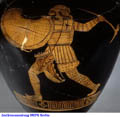 |
Now we turn to Greek depictions of Persians and Greeks on vases. How do Greeks portray Persians and themselves? "A bearded Persian lunges to the left, his wicker shield over his forward-extended left arm, his right arm thrown back as he prepares to strike with his axe. He wears a patterned 'body-stocking,' a short, decorative tunic, soft shoes, and a soft cap with dangling pieces flopping over his ears. A quiver hangs by a cord draped over his shoulder." |
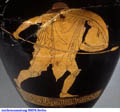 |
"A Greek moves to the right, his shield held on his left shoulder, his spear held ready in his right hand. He wears chlamys, greaves and a domed hat, and he has a straggly beard." Note that the image does not show the breastplate that a hoplite would use, but instead depicts the warrior with heroic nudity. |
 |
In this vase, hoplites arm for battle. One puts greaves on his calves, another wraps his chest with a corselet, while another holds a helmet. |
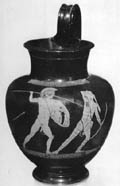 |
"A youthful Greek advances to right aiming his spear at a bearded Persian, who, having shot an arrow past his adversary, draws back and strives to defend himself with his sword. The Greek wears a crested Attic helmet (decorated on the side with a floral ornament and on the raised cheek-piece with a snake), greaves, and a sword hanging from a cross-belt. The shield on his arm is seen in perspective from within. The Persian is in oriental costume consisting of a cap, with its flaps lowered, a tight-fitting sleeved tunic and trousers. His quiver hangs from a cross-belt." L. D. Caskey, J. D. Beazley, Attic Vase Paintings in the Museum of Fine Arts, Boston. |
 |
In this aerial photograph, you can see the mountains and the middle pass at Thermopylae, where 300 Spartiate soldiers under the command of Leonidas held off the Persians. |
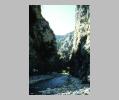 |
The Asopus River runs through the gorge, not far from the battle site. This view reveals the narrowness of the middle pass. |
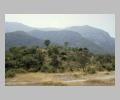 |
Here is a photograph of the Spartan burial mound at Thermopylae; its untended state belies its significance to Spartan valor. |
Photo credits:
Gold Daric, Dewing 2710, Photograph by Maria Daniels, courtesy of the Dewing Greek Numismatic Foundation.
Glazed relief of a Persian warrior, from Susa. Louvre.
Nolan Amphora, Berlin F 2331: Side B: scene at center
Photograph by Maria Daniels, courtesy of the Staatliche Museen zu Berlin, Preußischer Kulturbesitz: Antikensammlung.
Attic Red Figure Oinochoe, Boston 13.196: Main panel: Greek and Persian in combat
From Caskey & Beazley, plate XVIII. With permission of the Museum of Fine Arts, Boston.
Aerial view of Middle Pass, from NW, Thermopylae,
Photograph by Raymond V. Schoder, S.J., courtesy of Bolchazy-Carducci Publishers.
Asopus Gorge near battlesite, Thermopylae, photograph courtesy of Thomas Martin and Ivy S. Sun.
Burial Mound for Spartan dead at Thermopylae, photograph by Beth McIntosh and Sebastian Heath, August 1990.